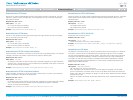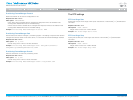
D14850.02 MX Series Administrator Guide (TC5.0) | 2011 NOVEMBER | © 2011 Cisco Systems, Inc. All rights reserved. www.cisco.com
47
Cisco TelePresence MX Series
ADMINISTRATOR GUIDE
Enter the NTP Address to define the network time protocol server address. This address will
be used if NTP Mode is set to Manual, or if set to Auto and no address is supplied by a DHCP
server.
ADMIN
<S: 0, 64>
Format: String with a maximum of 64 characters.
NetworkServices NTP Address: "1.ntp.tandberg.com"
Determine whether the system should be able to place and receive SIP calls or not. NOTE:
Requires a restart of the codec.
ADMIN
<On/Off>
On: Enable the possibility to place and receive SIP calls (default).
Off: Disable the possibility to place and receive SIP calls.
NetworkServices SIP Mode: On
SNMP (Simple Network Management Protocol) is used in network management systems to
monitor network-attached devices (routers, servers, switches, projectors, etc) for conditions that
warrant administrative attention. SNMP exposes management data in the form of variables on
the managed systems, which describe the system configuration. These variables can then be
queried (set to ReadOnly) and sometimes set (set to ReadWrite) by managing applications.
ADMIN
<Off/ReadOnly/ReadWrite>
Off: Disable the SNMP network service.
ReadOnly: Enable the SNMP network service for queries only.
ReadWrite: Enable the SNMP network service for both queries and commands.
NetworkServices SNMP Mode: ReadWrite
Enter the address of up to three SNMP Managers.
The system's SNMP Agent (in the codec) responds to requests from SNMP Managers (a PC
program etc.), e.g. about system location and system contact. SNMP traps are not supported.
ADMIN
<S: 0, 64>
Format: String with a maximum of 64 characters.
NetworkServices SNMP Host 1 Address: ""
Enter the name of the Network Services SNMP Community. SNMP Community names are used
to authenticate SNMP requests. SNMP requests must have a password (case sensitive) in order
to receive a response from the SNMP Agent in the codec. The default password is "public".
If you have the Cisco TelePresence Management Suite (TMS) you must make sure the same
SNMP Community is configured there too. NOTE: The SNMP Community password is case
sensitive.
ADMIN
<S: 0, 50>
Format: String with a maximum of 50 characters.
NetworkServices SNMP CommunityName: "public"
Enter the name of the Network Services SNMP System Contact.
ADMIN
<S: 0, 50>
Format: String with a maximum of 50 characters.
NetworkServices SNMP SystemContact: ""
Enter the name of the Network Services SNMP System Location.
ADMIN
<S: 0, 50>
Format: String with a maximum of 50 characters.
NetworkServices SNMP SystemLocation: ""
SSH (or Secure Shell) protocol can provide secure encrypted communication between the
codec and your local computer.
ADMIN
<On/Off>
On: The SSH protocol is enabled.
Off: The SSH protocol is disabled.
NetworkServices SSH Mode: On
Introduction
Table of contents
Web interface
Advanced settings
Appendices
Advanced settings


















